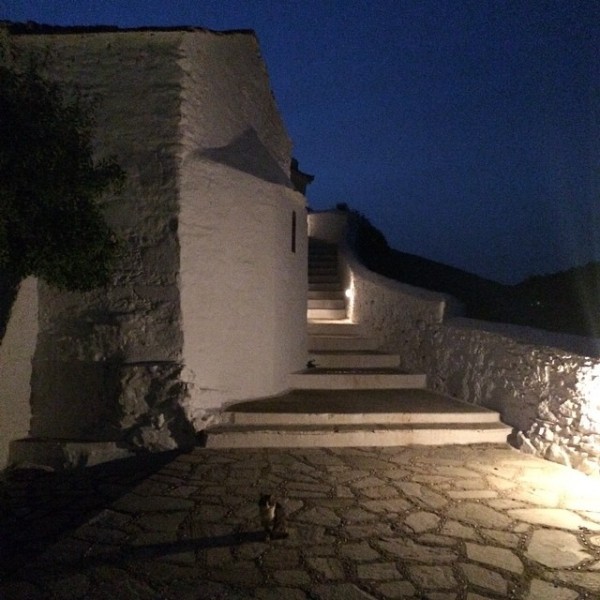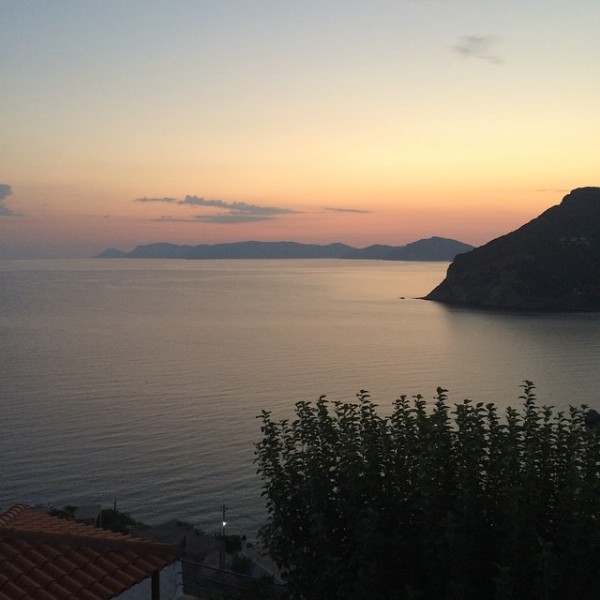Layers
Last evening I walked down into the village to shop for groceries. Coming back I took a different route and found myself climbing a set of stairs so steep they terrified me. On the right was only ocean. They were, I realized, the steps of the ancient fortress that used to guard the town. They ascended past dozens of little homes, tucked seamlessly into the fortress walls. I wasn’t sure if the dwellings were as old as the fortress, or just another layer of history tacked on top of the original. Reading later I discovered that the site was originally the town’s acropolis around 700 BC, and then became the site of a Venetian castle. In any case the dwellings were charming: stone covered with stucco, cajoled into organic forms, the whole spiraling up like an giant conch shell. There were doors in every shade of blue, and lush flowering plants and succulents tumbling from pots and growing out of tiny crevices in the cobblestones.
People sat outside on patios or balconies or stoops, chatting. Candlelight, torches and lamps lit my way. In this enchanting part of Skopelos the streets are all steps. You ascend to home, and you descend into town. They twist and twine, and there is no room for anything larger than a motor scooter. The garbage is collected by a man leading two mules. There’s a gutter than runs down the middle of every stair, so when I passed a man at the top of the village, watering his plants, the water raced by me down the stairs all the way to the harbor. There is probably not a single right angle anywhere to be found, and scattered among the dwellings are at least five, I thought, tiny Greek Orthodox churches, old, embellished, and painted pristine white. I later discovered that there are not five, but five dozen churches in Skopelos Town, each like a jewel box, loved and honed and glorified over the span of time.
All along my way people were taking the night air, seated on their steps, or just inside their tiny patios. I would say one of my two words of Greek as greeting, and they would say it back to me.
Last week I had the privilege of meeting Nikos Rodios, a well known ceramic artist from a distinguished family of potters. Jill Somer, the director of the Skopelos Foundation for the Arts, took me to visit his studio. It dates back to 1900, when his paternal grandfather established it there, on the Skopelos Town waterfront. Rodios, as he is known, creates pots in traditional Greek forms, and then hand burnishes them and fires them in the back of the shop in an olive wood fired kiln that looks to be about a hundred years old. The pots are turned on his uncle’s kick wheel. They are unglazed, but are gun metal black from reduction firing. Rodios has a brilliant sense of design and he transforms these traditional shapes by attenuating them, stretching and exaggerating the forms, and emphasizing every linear element. They are breathtakingly beautiful and accomplished. Jill translated our conversation for us, and told me that Rodios digs his own clay. She said he often finds ancient artifacts in his digging. In Greece, everything, including the food is layered. Rodios knows, better than anyone, that he sits on top of several thousand years of previous potters.
As Rodios threw a pot for me to watch, he was also being watched with total intensity by a little boy– son, grandson, or nephew– I’m not sure, but a family member, perhaps 9 or 10 years old. I got Jill to ask him the little boy if he was learning to turn and he responded that he was not, but his desire was palpable. I ‘m pretty confident that I was looking at the layer to come of Rodios potters.




Recent Comments